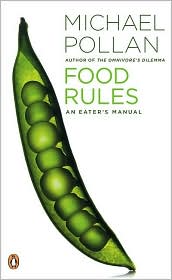
Michael Pollan's Food Rules: An Eater's Manual is such a quick read at only 139 pages that I almost forgot to write about it here after I read it all in one afternoon. Pollan writes in his other books about his simple "diet" philosophy: Eat food, not too much, mostly plants, and this book is divided into three sections based on those three ideas. Each section contains "rules" meant to guide you towards creating a food culture for yourself that avoids the traps of modern industrial processed food and establishes healthier eating patterns.
Disclaimer: Let me just say that I usually cringe at the thought of "healthy lifestyles." I sneer at exercise, I've never been inside a gym, I don't run (weak ankles!), and I hate "health food." Foodies and trendy diet nuts are to be avoided. I like bourbon, butter, and backsliding. I love caffeine and chicken friend steak. Nevertheless, some of the "food" that I see advertised on TV scares the bajeezus out of me. What are we eating, America?! It's not right.
So I appreciate that Pollan is offering up 64 completely commonsensical tips for doing a better job of consuming actual food in reasonable portions. Here are some of my favorites:
#2: Don't eat anything your great-grandmother wouldn't recognize as food.
#11: Avoid foods you see advertised on television.
#19: If it came from a plant, eat it; if it was made in a plant, don't.
#36: Don't eat breakfast foods that change the color of the milk.
#39: Eat all the junk food you want as long as you cook it yourself.
#47: Eat when you are hungry, not when you're bored. "If you're not hungry enough to eat an apple, then you're not hungry. Food is a costly antidepressant." - I've actually been using this test. It makes so much sense!!
#63: Cook.
#64: Break the rules once in a while.
As always, whenever someone lays out some simple, honest Truths for you, it feels good to embrace them. Buy this book! (Thanks Jane and Dale for buying me this book!)

